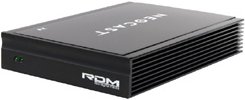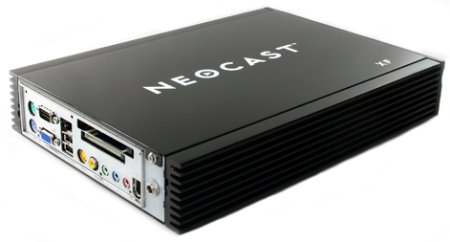Device Profile: Real Digital Media XF digital sign
Apr 15, 2005 — by LinuxDevices Staff — from the LinuxDevices Archive — 34 viewsReal Digital Media (RDM) has used Linux and a Via-based embedded computer board to build a networked digital signage product with Flash and central management capabilities. The company expects the digital signage market to standardize on Linux, because its stability gives it “obvious advantages.”

The Media Player XP appears to be a mini-ITX system
RDM's Neocast Media Player XF is a second-generation design that builds on the earlier Media Player X. Both products work with RDM's Media Player Server, a Web-based, hosted application that runs in an IBM ASP (application service provider) facility. The products target point-of-purchase marketing, advertising, and corporate communications networks, RDM says.
RDM says its Neocast system can narrowcast customized messaging to individual displays, or broadcast content to entire networks of displays. Displays can also be grouped by demographics such as specific store departments, or geographies. And, owners of the systems can “day-part” their networks, RDM says, selling time to others to offset costs.
What's under the hood?
The Media Player XF is based on a 1GHz Via processor, and has 512MB of RAM. It boots from a 40GB hard drive, which is also used to store signage content and playlists.
The Player supports SXGA (1600×1200) VGA displays, and also has an S-Video port to support display on televisions. The audio system includes analog and digital (S/PDIF) ports, and is capable of decoding both 44.1KHz and 48KHz files, RDM says. Supported formats include MPEG-1 audio layer II, 2-channel fixed, AC3, and MP3.

The Media Player appears to be based on a VIA MII10000 mini-ITX board
Additional I/O ports include Firewire, Ethernet, PCMCIA, RS232, and USB, and the device has a CompactFlash slot as well. Although RDM did not specify, the specifications seem to match those of VIA's Epia MII-1000 mini-ITX board.
Software side
The Media Player runs a Linux implementation developed by Koos Technical Services, according to RDM. The implementation is based on an unspecified version of Red Hat Fedora Linux and the DirectFB graphics system. Supported playback formats include JPG, GIF, PNG, MPEG-1, MPEG-2, DivX, WMA, and VOB files, as well as Flash and Shockwave — the Media Player is a Macromedia Flash certified device, according to RDM.
Flash is increasingly used in digital signs and other device applications, according to Vibren, an engineering services firm deputized by Macromedia to resell embedded Flash technology to low-volume licensees such as device makers.
RDM's, VP of marketing, Jason Broom, believes that Linux has a bright future in the digital signage market. He said, “RDM selected Linux due to the operating system's stability. Those experienced in the digital signage industry understand the value Linux provides over PC-based solutions, and we believe the market will standardize on the Linux approach.”
However, Broom adds that world signage domination will not happen without evolution. He says, “Continued and increased support for video and audio standards will be necessary. Display rendering technologies such as Apple's Quartz and Microsoft's upcoming Longhorn graphics subsystem present enticing features not yet widely available in Linux.”
Other vendors of Linux-based electronic signage products include Lucid Signs and First Technologies.
This article was originally published on LinuxDevices.com and has been donated to the open source community by QuinStreet Inc. Please visit LinuxToday.com for up-to-date news and articles about Linux and open source.